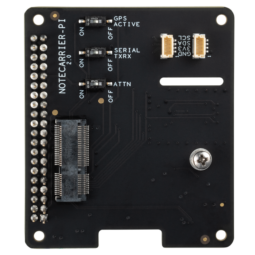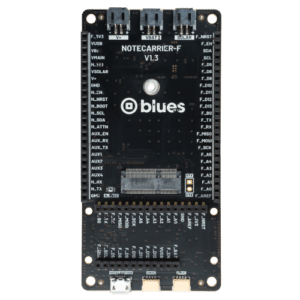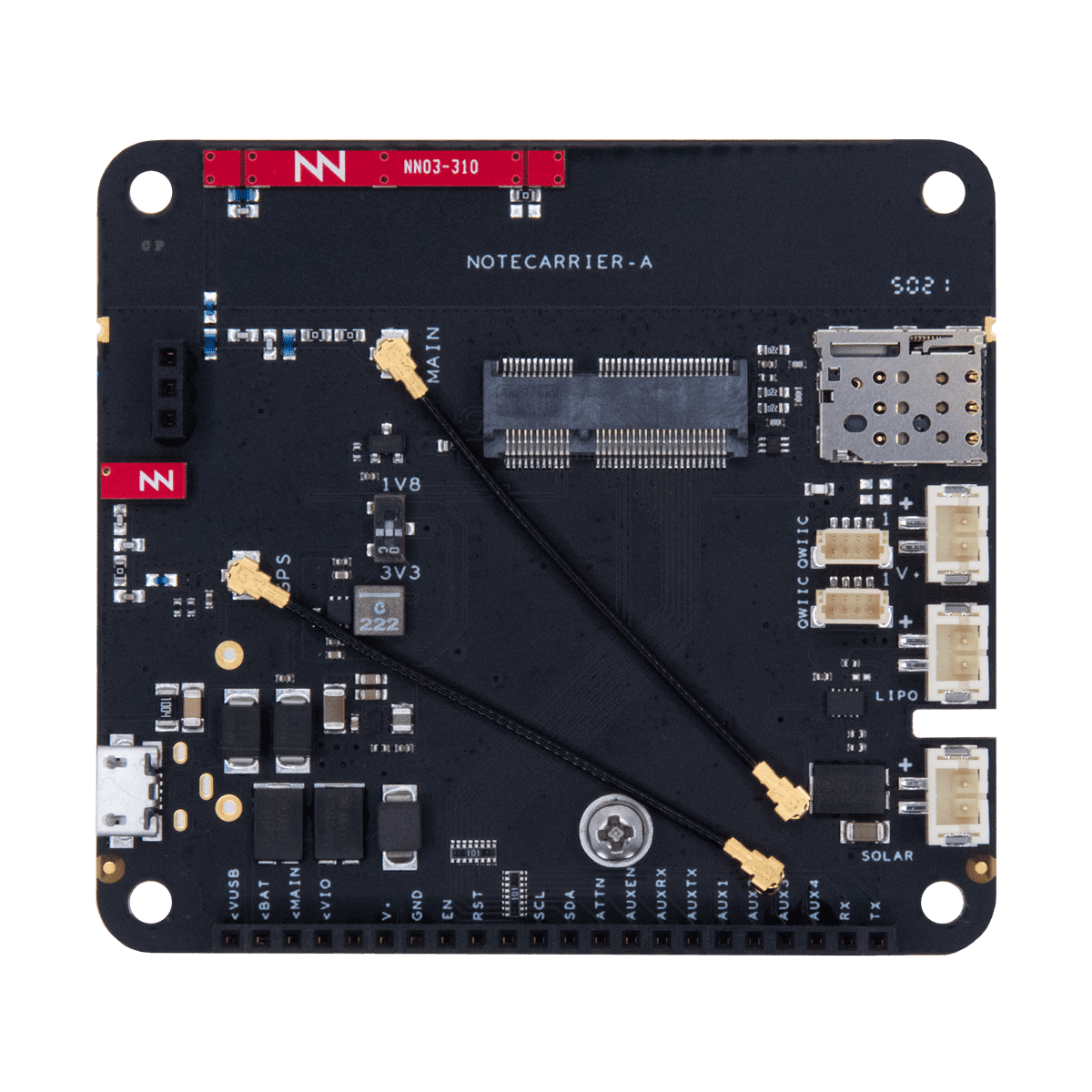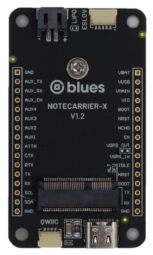The Notecarrier Pi
Designed for drop-in development with a Raspberry Pi or Pi-compatible Single Board Computer.
Best Notecarrier For Raspberry Pi SBC
Pi Hat with stackable, passthrough headers
Two Qwiic I2C ports for external peripherals
U.FL cellular/Wi-Fi antenna included with Notecarrier Pi

-
Notecarrier Pi (Raspberry Pi Hat)
- Pre-soldered stackable 40-pin header for plugging into a RPi
- M.2. Key E edge connector and screw-down port for Notecard
- Nano-SIM slot for (optional) additional carrier connectivity
- Two Qwiic I2C port for attaching external peripherals
- Includes U.FL cellular/Wi-Fi antenna (GPS requires U.FL active antenna)
- Micro-USB to power device and provide USB interface to Notecard
- This product requires a Notecard
Tech Specs
Please Note:
There are several key differences between the Notecarrier Pi and other Blues Notecarriers:
- No support for battery monitoring or charging
- Supports 3V3 only and is powered directly by the Raspberry Pi
- Doesn't offer I2C clock stretching (therefore I2C errors are more common)
- Doesn't support the Notecard's AUX 1-4 pins (therefore card.aux is not supported)
- Provides serial access via AUX RX/TX (therefore there is limited support for card.aux.serial)
Size
- 52mm x 61mm
Compatible Notecards
Compatible MCUs
- Raspberry Pi with standard 40-pin header
Connections
- M.2 Edge Socket
- Micro USB Port
- Nano-SIM Slot
- 2x Qwiic Connectors for I2C Peripherals
Headers
- Pre-soldered Raspberry Pi standard 40-pin header
Switches
- Active GPS DIP Switch
- Attention Pin DIP Switch
- Serial Port DIP Switch
Temperature Ratings
- -35 ° C min - 70 ° C max
Power Ratings
- Supply Voltage: 2.5V min - 5.5V max
- Supply Current: 500mA min - 2000mA max
Additional Information
Which Notecarrier is right for me?
Discover the right Notecarrier for your host, power supply, and deployment stage.

Notecarrier F
Best when using Feather-compatible MCU
103mm x 51mm
Adafruit Feather-compatible
Bring Your Own Antenna
Two Qwiic I2C Ports
LiPo/Solar/V+
Micro USB
External Nano-SIM Socket for Additional Carriers

Notecarrier Pi
Best when using a Raspberry Pi-compatible SBC
56mm x 65mm
Raspberry Pi
External Cellular/Wi-Fi Antenna
Two Qwiic I2C Ports
Pi HAT
Micro USB
External Nano-SIM Socket for Additional Carriers

Notecarrier A
Best when prototyping with any other MCU
68mm x 75mm
Any MCU
Embedded Antennas
Two Qwiic I2C Ports
LiPo/Solar/V+
Micro USB
External Nano-SIM Socket for Additional Carriers

Notecarrier X
Best for small form factor deployments
66mm x 38mm
Any MCU
Bring Your Own Antenna
One Qwiic & One ESLOV I2C Port
2.5V-5.5V to V+
USB-C
External Nano-SIM Socket for Additional Carriers
Frequently Asked Questions
The Notecard and its companion Notecarrier-Pi HAT support virtually any Raspberry Pi-compatible single-board computer (SBC) with a 40-pin male header connector. Some examples of compatible SBCs include the balenaFin, Banana Pi, and the ROCK Pi.
Note that due to the power requirements of the Notecard, some Raspberry Pi 2 and 3 models include a current-limiting fuse that will power-cycle the device when the Notecard’s modem is on and transmitting. To avoid these issues, we recommend using Raspberry Pi 4 devices with the Notecard and Notecarrier Pi HAT.
The Notecard, combined with the Notecarrier-A, is the easiest way to add cellular connectivity to your MCU-based IoT project. Blues provides a Feather Starter Kit that includes a Swan, a feather-compatible MCU, to get you started as quickly as possible. Alternatively, if you are invested in the Raspberry Pi platform, you can get started with the Raspberry Pi Starter Kit.
No! The Notecard is a small 30mm x 35mm system on module (SoM) that is able to be embedded in any IoT project on its own via its M.2 edge connector.
However, Blues provides a variety of Notecarrier host boards for easily adding cellular connectivity to a new or existing IoT solution for prototyping purposes. The Notecarrier also provides antennae for both the GPS and cellular capabilities of the Cellular Notecard (and the cellular antenna is also compatible with the Wi-Fi Notecard).
- Notecard: SoM peripheral with a cellular modem, IMU sensor, GPS modem, with an M.2 edge connector.
- Notecarrier: A prototyping board with cellular/Wi-Fi and GPS antennae, used to breakout the pins on the Notecard’s M.2 connector.
- Notehub: A cloud service, used as a backend to connect with the Notecard. Notehub securely receives all data and communications created by the Notecard. In turn, Notehub can securely sync encrypted data with the cloud application of your choice using VPN tunnels which eliminates the need for traffic to traverse the public Internet.
We’re making IoT quick and easy.
Start your IoT journey with us!